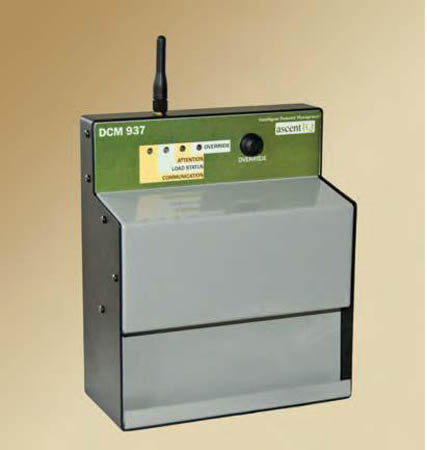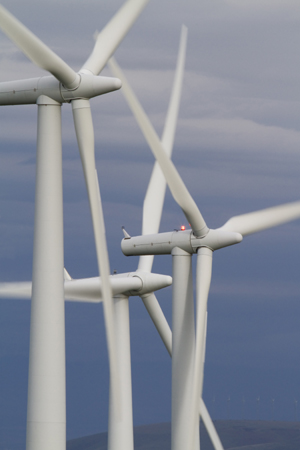Wind power is one the rise in the U.S., thanks in part to a flurry of federal and state incentives, as are smart grid and smart meter systems aimed at helping homeowners save money and utility companies reach new efficiency mandates. A new pilot program between the Bonneville Power Administration (BPA)–one of the largest distributors of electricity in the Pacific Northwest–and one of their member utilities, Mason County Public Utility District Number 3 (MCPUD3) is combining these two technologies in a novel way, helping to store wind power for home use.
Storing power has long been an issue for weather-based renewable energy systems such as wind and solar, as the electrical grid relies on a steady source of electricity to avoid surges and black-outs. Rather than going for a big, centralized solution to the storage issue–such as pumped hydro or sodium sulfur batteries–BPA and MCPUD3 are starting with a simple, distributed storage method utilizing an existing technology that’s already located in your home: the water heater.
As part of the pilot program, MCPUD 3 will install special devices on water heaters that will communicate with the electrical grid and tell the appliances to turn on or off, based on conditions of the regional electrical system and the amount of renewable energy available. When the wind blows and turbines produce electricity, the water heaters of participating homeowners will fire up, reducing the demand for electricity from other sources when family members turn on the hot water.
To help us get a handle on how all of this works, and what the implications are, we turned to Lee Hall, BPA’s Smart Grid and Demand Response Program Manager.

EarthTechling (ET): One of the goals of Mason County Public Utility District 3’s pilot program is to help to move the demand for electricity from peak to off-peak times. How does this help both the utility and the homeowners involved?
Lee Hall (LH): The simultaneous use of electricity in the region causes a significant increase in demand for power, which can strain the electrical system. Turning off the water heaters during this period of peak use can help level out the spike in energy consumption and ease that strain.
For the utility and its customers, this reduces the fees a utility has to pay for their peak power demand. For the region, reducing electricity during peak use periods can ease strain on the federal hydro system. The demand for electricity is growing, as are operational demands to protect fish runs and integrate variable resources such as wind. Flattening out electricity use can help keep rates lower by reducing the need to purchase more costly market energy to meet periods of higher demand.
For Mason County PUD #3 customers, they will also get the ability to integrate renewable energy, in the form of wind power, into their homes. That’s something they can feel good about.
ET: We’ve seen a lot wind power go up since 2008, thanks in large part to federal and state incentives. But as the grid relies upon production being balanced by demand at all times, the intermittency of wind power has posed a real problem for utilities working to integrate wind power into an existing infrastructure. How does a program like this have the potential to help manage the intermittency of wind?
LH: To thoroughly understand the benefits of the project, you have to understand a basic principle of an electrical system. That is, at any given moment, the amount of electricity consumed must match the amount that is generated. Otherwise, the grid can destabilize, causing a blackout.
Shifting water heater energy use to a time when consumption is lower helps level out the peaks and valleys of energy use, which makes the balancing act of supply and demand a little easier. This is especially valuable when managing variable power sources like wind power.
With enough of these “storage units” in place, the region can reduce the need to rely on the hydro system to maintain the power system balance of supply and demand. With increasing demands on the Northwest hydro system, this project provides a valuable additional source for system flexibility. The goal is for the device to find the balance between making sure the homeowner has enough hot water, while making wise use of wind power in the system. This program is just one of many tools the region is using or testing to help integrate wind.

ET: This program makes use of a device attached to a homeowner’s water heater, which then communicates with the electrical grid. How does this work?
LH: The device can communicate using either broadband connections or cellular communications. It provides two-way communication between the water heaters and the Nine Canyon wind project located near Kennewick, Washington. The technology will collect and analyze data, and provide a signal, in real-time, to help integrate wind.
ET: A recent BPA release states that one of the goals of this pilot program is to “see if the device can find out when wind power is readily available and fire up the water heaters to take advantage of it.” What does that mean, exactly?
LH: This is the nuts and bolts of the program. First, the program will collect data to determine the energy consumption habits of customers participating in the program. That will help ensure we properly align the wind power with their use. After about two weeks of data collection, the pilot will officially begin. The technology will blend the information about power consumption and combine it with wind forecasts to make best use of wind energy. For example, if the forecast says the wind will start blowing in about four hours, the program will turn off water heaters in advance – but only if we know the consumer typically doesn’t take showers during that time frame – so the water heaters can kick back on when the wind event happens. In essence, we will shift the power consumption of the water heaters to coincide with when the wind energy is being generated.

ET: Are programs like this currently in place in any other areas of the country?
LH: I’m not aware of any program in the country that uses this specific technology. Certainly, this is the first time BPA has participated in a pilot project that uses two-way communication between water heaters and wind generation.
ET: If this pilot program proves successful, what are the plans for expanding it?
LH: Ideally, we’ll see an expansion of all types of smart grid technology. It’s sort of like the smart phones that we use now. They are very different than what Alexander Graham Bell invented and the improvements evolved over time. The evolution of smart grid will also take time, but the ultimate goal is for consumers to be able to choose when, how, and at what price they use electricity. For this project specifically, it’s too soon to tell if or how we might expand it. We’ll see what lessons we’ve learned after the pilot project and determine if this can become a tool for widespread use.